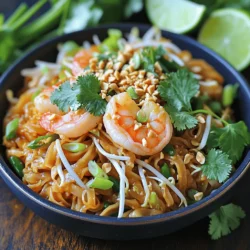
- Easy Pad Thai with Shrimp
Whip up a delightful Simple Shrimp Pad Thai in just 30 minutes with this easy recipe! Featuring tender shrimp, crunchy bean sprouts, and flavorful rice noodles, this dish is perfect for a quick weeknight meal. Discover how to achieve that authentic Pad Thai taste with our simple step-by-step guide, and don't forget to garnish with peanuts and cilantro for an extra burst of flavor.